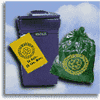Container Options
Other Topics
- Implementation Timeline
- Administration and Staffing
- Billing
- Container Options
- Consensus Building (Gaining Public and Political Support)
- Education and Outreach
- Enforcement
- Goal Setting
- Illegal Diversion (Dumping, Burning)
- Legal Issues (Ordinances)
- Monitoring and Evaluation
- Apartment/Multi-Family Housing
- Pilot Programs
- Pricing Systems
- Rate Structure Design
- Recycling and Other Complementary Programs
- Results
- Scheduling Issues
- Special Populations
- Volume- vs. Weight-Based Programs
Communities implementing pay-as-you-throw must select the type and size of trash container they will use. Many communities distribute distinctively marked cans or bags. Others use stickers or tags, which residents affix to the bags or cans they set out for collection.
For communities planning a pay-as-you-throw (PAYT) program, choices about containers and rate structures go hand in hand. In some cases, container type will dictate the rate structure local officials use. In other cases, a community may favor a rate structure that lends itself to a certain type of container.
A PAYT program can be designed around any one of the container options described below. Each system has its advantages and disadvantages related to such issues as offering a system that residents view as equitable, creating as direct an economic incentive for waste reduction as possible, and assuring revenue stability for the solid waste agency.
Variable cans
Under this system, the municipality offers households a set of standard, graduated can sizes. These sizes range from approximately 10 to 90 gallons in capacity, although cans in the 30- to 60-gallon range are the most common. Typically, these systems operate on a subscription basis, under which residents choose in advance the size of the can they wish to use (often called the subscription or service level). Other communities ask collection crews to record the number of cans left out. Bills based on service level or number of cans set out are then sent to households, usually monthly or quarterly.Advantages:
- Greater revenue stability under subscription systems, since revenues vary only when residents change their service level.
- Compatibility with automated collection systems.
- Cans prevent litter from blowing and animals from scattering trash.
- Reduced waste reduction incentive, since residents are billed the same amount whether they fill their can halfway or completely.
- Inventory and distribution system needed for cans.
- Billing system needed to collect revenues.
Prepaid bags
 This system uses colored (or otherwise distinctively marked) standard-sized
trash bags, usually 20 to 30 gallons in capacity. Residents purchase the
bags from the solid waste agency through outlets such as municipal offices
or retail stores. Municipalities include in the cost of the bag all or some
of their waste collection and disposal costs. Collection crews are instructed
to pick up only trash that is placed in the bags.
This system uses colored (or otherwise distinctively marked) standard-sized
trash bags, usually 20 to 30 gallons in capacity. Residents purchase the
bags from the solid waste agency through outlets such as municipal offices
or retail stores. Municipalities include in the cost of the bag all or some
of their waste collection and disposal costs. Collection crews are instructed
to pick up only trash that is placed in the bags.
Advantages:
- Residents save money whenever they put out fewer trash bags, creating a strong waste reduction incentive.
- Lower administrative costs, since residents pay directly for bags at municipal offices or local retailers.
- Lower implementation costs than can systems.
- Easy for residents to understand and use.
- Greater revenue uncertainty, since residents can buy many bags at once and then none for several weeks.
- Bags might not be compatible with automatic collection systems.
- Animals might tear bags and scatter trash.
Prepaid tags or stickers
Tags or stickers are designed to be used in tandem with different types of containers. Under this system, residents purchase tags or stickers from the solid waste agency through municipal offices or retail stores and attach them to their own trash bags or cans. The tag or sticker specifies the size of the container it covers. As with bag systems, municipalities include in the cost of the tag or sticker all or some of their waste collection and disposal costs. Collection crews pick up only those bags or cans that have the appropriate tags or stickers attached to them.Advantages:
- Residents save money whenever they use fewer tags or stickers on their trash containers, creating a strong waste reduction incentive.
- Lower administrative costs, since residents pay directly for tags or stickers at municipal offices or local retailers.
- Lower implementation costs than can systems.
- Residents can choose the types of containers they prefer.
- Greater revenue uncertainty, since residents can buy many tags or stickers at once and then none for several weeks.
- Need to establish and enforce size limits for each type of sticker.
- Tags and stickers may be stolen from trash containers.
- Need to offer residents stickers that will not fall off in rainy or cold weather.
Choosing the right container type will take careful consideration. Communities don't have to be locked into one type of system if they plan for the possibility of change. Some communities conduct a pilot program in one part of the municipality before fully implementing PAYT. In this way, they can work out difficulties early in the process, when modifications are still relatively easy.
Additional resources
For help making a decision about which container to use, go to the worksheet on container options (PDF) (21 pp, 331K, about PDF) (Worksheet 4 in the set of seven worksheets) in the Pay-As-You-Throw Tool Kit. This worksheet reviews the advantages and disadvantages of each container and offers a step-by-step process to help you select the most appropriate system for your community.For answers to questions about containers and how they are used in a PAYT program, visit container options in the Frequent Questions section of this Web site.
![[logo] US EPA](../gif/logo_epaseal.gif)